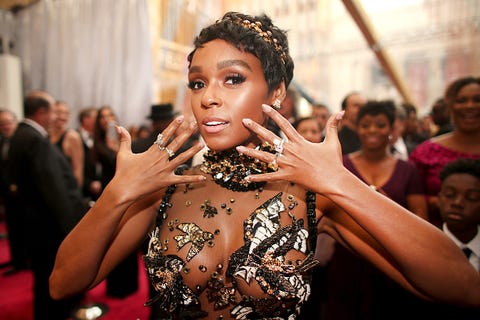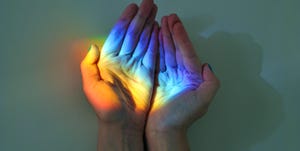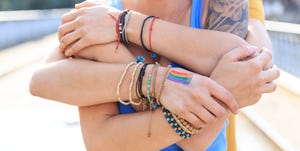
The term “pansexual” has been getting a lot of attention lately, thanks to celebrities like Janelle Monáe and Miley Cyrus, who have opened up about being pansexual.
In April, Janelle told Rolling Stone about her pansexuality. “Being a queer black woman in America, someone who has been in relationships with both men and women—I consider myself to be a free-ass motherf#cker,” she said. Janelle says she originally identified as bisexual, but realized that label didn’t quite fit. “Later I read about pansexuality and was like, ‘Oh, these are things that I identify with too,'” she said. “I’m open to learning more about who I am.”



Miley had a similar journey to pansexuality. In 2016, she told Variety that she had a hard time understanding her own gender and sexuality. “I always hated the word ‘bisexual’ because that’s even putting me in a box,” she explained in the interview. “I don’t ever think about someone being a boy or someone being a girl…My eyes started opening in the fifth or sixth grade. My first relationship in my life was with a chick.”
Then in a recent interview with Billboard, Miley opened up a bit more about her status as a pansexual: “Who I’m with has nothing to do with sex,” she said. “I’m super-open, pansexual, that’s just me.”
So what is pansexuality and how does it differ from other LGBTQ identities? The experts have some insight.
1. It’s a real thing.
“There are a lot of stereotypes and misconceptions about pansexuality, and one of the most prominent ones is that pansexuality doesn’t exist, or isn’t a ‘real’ sexual identity. This is absolutely false,” says Corey Flanders, Ph.D., an associate professor of psychology and education at Mount Holyoke College. If a pansexual’s sexual identity is denied by others or they’re prevented from accepting their own identity, it can stifle them to a certain degree, she says.
2. Pansexual isn’t the same as bisexual.
Pansexual: Attracted emotionally, romantically, and/or sexually to people of all genders and sexes.
“’Pan’ comes for the Greek word ‘all,’” says Holly Richmond, Ph.D., a certified sex therapist and marriage and family counselor. “Pansexual is not bi-sexual, it’s all sexual.” That means a pansexual person could be attracted to a man, woman, a transgendered person, or a non-gendered person (a person who chooses not to identify themselves by gender), Richmond says.
3. It’s not uncommon for people who once identified as bisexual to become pansexual.
Like Miley and Janelle, some people who formerly identified as bisexual later identify as pansexual. “Bisexuality as a term has experienced criticism for adhering to a binary system of gender, a.k.a. ‘I’m attracted to men and women,’ even though this strict definition of bisexuality doesn’t fit many bisexual-identified folks,” says Rena McDaniel, who has a master’s degree in counseling with a specialty in gender and sexual identity.

Pansexuality, on the other hand, is seen as “more inclusive” of people who are transgender or identify outside of the gender binary of man or woman, she says.
4. Younger generations are more likely to identify as pansexual .
There seems to be an age gap with this label. “Younger people are more likely to use pansexual as a term, while slightly older populations are more likely to use bisexual,” McDaniel finds.
5. Pansexuality doesn’t translate to promiscuity.
Pansexuals may be attracted to all people, but that doesn’t mean that they’re going to have sex with anyone, Richmond says. “Pansexuals can be very choosy,” she says.
6. Pansexuals want relationships, too.
“One of the ways society shames those who are attracted to more than one gender is to say that they are ‘greedy’ or a ‘commitment-phobe,'” McDaniel says. “However, no one says this about heterosexual folks who also have about half the population of the world to choose from.”
Being attracted to more people has nothing to do with the kind of relationship a person wants to have with their partner or partners, she adds.
7. The term pansexuality only emerged recently.
Richmond says she first started learning about pansexuality five or six years ago at a conference for the American Association of Sexuality Educators, Counselors, and Therapists. Although pansexual people have definitely been around longer than that, the general public is just starting to acknowledge the term and learn what that sexual identity means.
8. Pansexuality has nothing to do with gender.
People often mix up gender identity and sexual identity but they’re not the same. “Pansexuality is a term that refers to sexual orientation, who someone is attracted to,” McDaniel says. “It is completely different from gender identity, which refers to how someone identifies their own gender.”

So pansexuality isn’t the same as transgender or gender non-binary, for example. Using pansexual as a label for your sexual orientation doesn’t say anything about your gender identity or the gender identity of the person you’re into, she says.
9. Less than 1 percent of the population identifies as pansexual.
Because pansexuality is a fairly new concept to many people, it’s hard to pinpoint exactly how many identify with the label, Richmond explains; she puts her best estimate at less than 1 percent. But as more people become aware of pansexuality, there may be more people who come to identify that way, she says.
10. Pansexuality isn’t just about sex.
When pansexuals are making a romantic connection, it’s very much about connecting with the person—not the gender, Richmond says. “It’s about developing meaningful relationships.”
Source: Read Full Article
